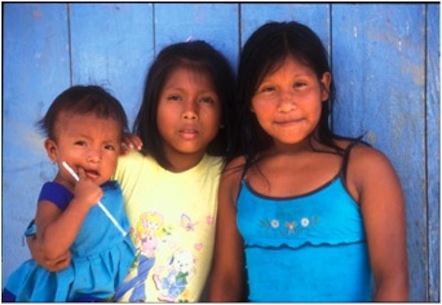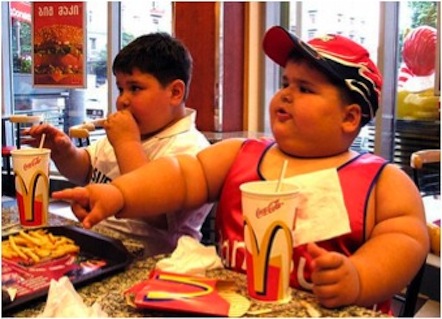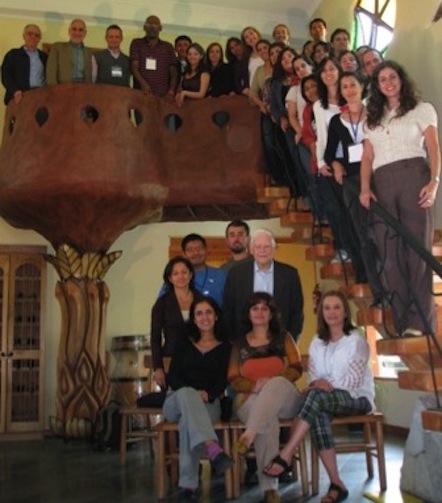World Nutrition
Volume 2, Number 1, January 2011
Journal of the World Public Health Nutrition Association
Published monthly at www.wphna.org
The Association is an affiliated body of the International Union of Nutritional Sciences For membership and for other contributions, news, columns and services, go to: www.wphna.org
Editorial
Our first and new year

So many nutrition journals! Indeed. Nevertheless, Association President Barrie Margetts, and the original Association Council, decided in late 2009 to launch an enlarged website, to be updated monthly. They also decided, when the time was right, to inaugurate World Nutrition as our monthly journal, modestly ‘nested’ within our website, because of a shared sense that we could and should focus on topics and approaches only occasionally attempted elsewhere. So here we are. We started last May, and skipped a month in the summer. So this is our eighth issue, and we are into Volume 2. How are we doing? Please tell us – the response facility is at the foot of this editorial.
WN and our website as a whole
We hear that the difference between WN and the rest of our website is sometimes not as clear as it could be. We agree.
All our work is ‘in progress’. Our website as distinct from WN can be seen as having four purposes. The first three closely relate. These are to promote our Association itself and our activities; to promote the profession of public health nutrition, and to carry news and feature stories about important events or developments, often by or about our members. The fourth purpose is to publish columns (or blogs) containing ideas, opinions and commentary.
The home page this month, together with the strip on its right hand side with its new summary contents, is an example of all these types of contribution. We lead with news of Rio 2012, our own congress. We think that Nestlé’s massive investment in new biotechnology may reshape the concept of nutrition. Barrie Margetts reports from Rome. The continuing saga of the UN Standing Committee on Nutrition (SCN) vitally affects what we profess. The fact that WN itself has contributed to the recognition of our founder member Carlos Monteiro as a Brazilian national leader is an exemplary news story. This month we report progress especially within less-resourced countries towards developing professional capacity. Our columnists Reggie Annan, Geoffrey Cannon, Fabio Gomes and Claudio Schuftan, based in or from Africa, Latin America and Asia, all of whom travel extensively, offer ideas and opinions, and reflect on their experiences and what they observe and believe.
World Nutrition is different. Its main contents are commentaries on important topics, more often than not by Association members. Starting in May, these have been by Michael Latham; Harriet Kuhnlein; Urban Jonsson; our first honorary life member Colothur Gopalan; Keith West, Rolf Klemm and Alfred Sommer; and Carlos Monteiro. Including short communications, letters and other contributions, so far over 30 people from all continents have signed WN contributions. Our publishing and editorial board so far includes Barrie Margetts (Chair), WN editor Geoffrey Cannon, and Ted Greiner, Roger Hughes, Urban Jonsson, Harriet Kuhnlein, Shiriki Kumanyika, John Mason, Carlos Monteiro, and Walter Willett.
WN is a journal that publishes ideas and opinion, rather than the results of research. Our general intention is to advance thinking and to improve policy and practice, including on contentious topics. This means that our commentaries tend to be challenging and sometimes even provocative. WN authors are and will be usually acknowledged leaders in our or associated fields, or else scholars with something substantial to say. Much of the rest of the contents of WN are short communications and letters responding to the commentaries – and we want more of these. In addition each issue carries an editorial. This may introduce and comment on the commentary or be on another topic. A new development is that WN will also occasionally publish position papers; examples are those of last month and this month on the governance and structure of the SCN.
It follows that there should not be significant overlap between WN and the rest of our website. Last month, however, we did publish a second commentary by Carlos Monteiro on his topic of ultra-processing, on and within our website home page. It belonged within WN. We have now made amends, by republishing a revised version in this issue of WN, together with a whole new commentary featured on this month’s cover.
The progress of WN
We monitor our progress, and we know that major WN commentaries are now attracting large numbers of readers, and are becoming influential. Each month our site is accessed by readers from over 70 countries, which itself is a vindication of on-line publication. Our May inaugural commentary by Michael Latham, severely critical of the current universal vitamin A supplementation policy, has been accessed and opened so far by over 3,000 readers and, perhaps more important, has ventilated the issue within relevant UN agencies, national government agencies, and funding organisations. Such figures underestimate actual readership, because networking of pdfs cannot be recorded.
Associated WN editorials, including that on the SCN, and important responses, notably including the October commentary by Keith West, Rolf Klemm and Alfred Sommer upholding current vitamin A supplementation policy, have also been extensively read and circulated, and proved to be influential. In November, overall site traffic measured as page sessions, largely driven by WN, was well over 30,000. (‘Hits’, not a meaningful statistic, were for that month over 275,000). So yes, we do think we are on the way to being rather more than ‘just another’ nutrition journal.
Have we got our priorities right? We are told that Carlos Monteiro’s November commentary on ultra-processing has been read and noted by the office of the US First Lady Michelle Obama. UN executives responsible for the governance of the SCN have found our news coverage and our WN position papers constructive and have thanked us. Does such news indicate that we are advancing the cause of our profession and of public health nutrition generally? We think so, yes. In representing the interests of our members, we believe we also need to reach out to a very much bigger and wider population. We profess and practice nutrition, but as the name ‘public health nutrition’ implies, we do not own it. Spreading the word is part of our duty and responsibility.
The place for celebration
We also are committed to upholding the rights and interests of peoples with small material resources, whose ways of life need to be protected, and who often have much to show and teach more materially rich peoples. A couple of years before his recent death well into his 90s John Waterlow, one of our mentors, urged public health nutrition journal editors to pay more attention to populations in want, women and children especially. We have, we hope, responded. Also though, so often we think of Africa and Asia in terms of impoverishment, food insecurity, undernutrition and even hunger and starvation, with good reason. But this is only one part of the whole story.
What nutrition is also all about, for nations and peoples in low-income countries and also in areas of the world remote from us, is well-being – joy in happy, active, fulfilled, well-nourished lives. This editorial begins with the WN cover picture for June last year. It is of three girls of the Awajún community of Nuevo Tutino, Perú. It introduced a commentary we have been proud to run, written by our founder member Harriet Kuhnlein of McGill University, whose great achievement has been to build up the worldwide CINE initiative that studies the food systems, ways of life, nutrition and health of indigenous peoples. Harriet was pleased to present her commentary as ‘Here is the good news’. For our part, we are as pleased by the circulation of WN in the communities in which Harriet’s colleagues work, as we are to think of the journal being read by Michelle Obama and her team in the White House.
A different world
Here below is the cover picture of our November WN, introducing Carlos Monteiro’s first commentary. This shows a very different story and very different children.

Their families have more money, but are they freer and happier? This looks unlikely. The commentary was accessed and opened by around 5,500 readers on the day after it came on-line, having been recommended on their social media by Michael Pollan, Marion Nestle and others, and its ‘page sessions’ now amount to around 16,000.
We are also proud to be the publisher of Carlos’s thesis, that ‘the issue is not so much nutrients, or food, so much as what is done to food before we consume it’. He is also careful to say that the issue is not food processing in general – how could it be? – but the extent, degree, purpose and intensity of processing, and specifically what he calls ‘ultra-processing’. His thesis fills the conceptual framework that we favour. It has social, economic, environmental and political as well as biological and metabolic dimensions. We have invited him to continue to contribute commentaries, to develop and exemplify his thesis. These will be published in addition to commentaries on other topics.
Our manifesto
To take stock, we are also looking again at the manifesto for WN, devised before its launch, which we publish every month. We will publish a revised version, guided by our Board, in due course. In the light of eight issues so far, and the next three or four now planned, we think it stands up well. It begins: ‘World Nutrition, the journal of the World Public Health Nutrition Association, is an international on-line journal. But there’s more to it than electronic technology. The essential difference between WN and other journals is one of scope and attitude. Typically, nutrition journals are mainly concerned with information, and seek to describe their world as it is. WN respects facts, and at the same time it is mainly concerned with ideas. It will see the world as it is, and also as it can and should be’.
It continues: ‘Other journals, notably Public Health Nutrition, publish the findings of original research. There is no need to duplicate this essential function. The need is for a journal whose contributors have scope to think and reflect on the significance of established and emerging experience and evidence, and on how best to shape policies and programmes that protect the human species, the living and physical world, and the biosphere, now and in future. This is part of the task of World Nutrition’.
The vision
Our manifesto then outlines the scope of the journal ‘The vision of WN is of nutrition as a social as well as a biological science, guided by ethical, ecological and evolutionary principles, and with economic, environmental and other dimensions. Debates, commentary, challenges to conventional wisdom – these are the kinds of contribution that WN will carry. It will support and celebrate all that is best about modern industrial and technological development. It will include discussion of the significance and implications of discovery and thinking, such as those now being made in the fields of epigenetics and systems theory. WN will also embrace the richness and variety of human experience and culture. It will pay attention to the points of view of societies and communities, in high-income as well as low-income regions and countries, that are impoverished or excluded, or that do not equate development with more cash, or whose ways of life are traditional’.
The manifesto says that WN is making a modest beginning. Indeed so. Its final page last month, completing our first volume of 7 issues, was 309, an average of just under 45 pages an issue. This year we plan to develop our editorial team, to plan well ahead, and often to publish two commentaries an issue, or a commentary and also a position paper. What we particularly want to gain is many more contributions in the form of responses – short communications and letters. The more voices, the better.
Our future

This editorial ends with the October WN cover, which so far is the one that best represents the aspirations of our profession. The picture was taken inside a pousada (guest-house) in the foothills of the mountains outside Santiago de Chile. It is of the Latin American young leaders’ course. Standing behind the course teachers in the front is Nevin Scrimshaw, one of the giants of our profession, who now well into his 90s continues to teach and to inspire. At the top left of the staircase – nicknamed Aconcagua for the purposes of the picture – are four renowned Latin American scientists, Fernando Vio, Ricardo Uauy, Juan Rivera and Noel Solomons, who when younger were mentored or influenced by Nevin and who are now at the peak of their careers. Between them on the stairs are the chosen young leaders from throughout Latin America, who in their part of the world, and no doubt internationally, are the future of our profession. It is already time for them to feature and flourish in World Nutrition.
From all of us at Volume 2, many greetings for this new year.
The editorial board
Acknowledgement and request
Readers are invited please to respond. Please use the response facility below. Readers may make use of the material in this editorial if acknowledgement is given to the Association, and WN is cited
Please cite as: Anon. Our first and new year. [Editorial] World Nutrition, January 2011, 2, 1: 1-7. Obtainable at www.wphna.org
The opinions expressed in all contributions to the website of the World Public Health Nutrition Association (the Association) including its journal World Nutrition, are those of their authors. They should not be taken to be the view or policy of the Association, or of any of its affiliated or associated bodies, unless this is explicitly stated.






